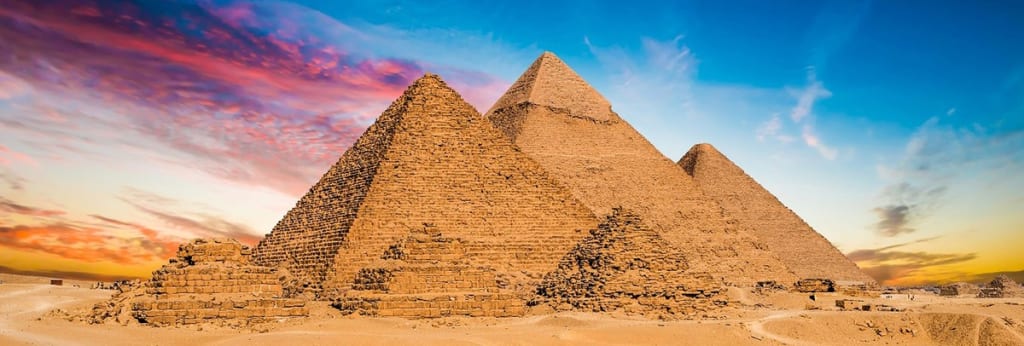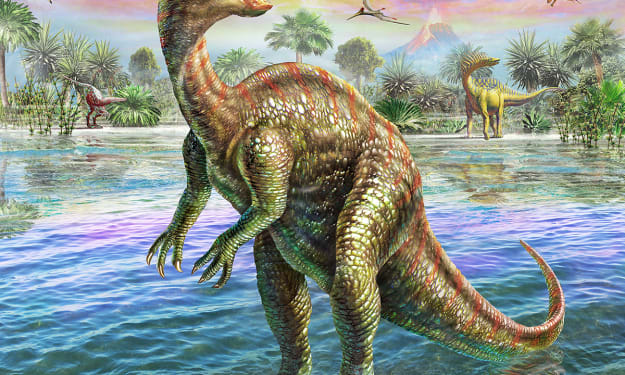The Mysteries of the Great Pyramids of Giza
Uncovering the Secrets of Ancient Egypt's Architectural Marvels

Consider the Great Pyramids, one of the original Seven Wonders of the World and the only one that still exists today. Did you know that the Pyramids of Giza weren't the only pyramids out there, and they weren't even the first ones? In ancient Egypt, it was believed that kings were chosen by gods to serve on Earth as their mediators. In the afterlife, they were expected to become gods themselves. The pyramid complex was built to ensure that the king had everything they might need in the afterlife, including a pyramid, palace, and temples. The tomb in the pyramid, where the king was buried, was filled with furniture, food, and gold vessels.
The first pyramid was built 80 years before the Pyramids of Giza appeared. Overall, there were around one hundred pyramids, but not all were completed, as construction took a long time and not every pharaoh lived long enough to see the end of it. The biggest of the Pyramids of Giza is as tall as a 40-story building. How did they manage to build such massive structures 5,000 years ago, long before modern machinery?
Pharaoh Khufu ascended the throne around 2575 BCE, and his architects began constructing the oldest and largest Pyramid of Giza. They used over 2 million limestone blocks, each weighing around 2.5 tons, roughly the weight of a rhinoceros. To finish the construction in 20 years, a stone had to be placed every 4 minutes, 24 hours a day, 7 days a week, 365 days a year. Contrary to popular belief, the workers were not enslaved people but rather came from all over Egypt to contribute to the project. Approximately 25,000 workers were involved, performing various tasks from manual labor to administrative work. They worked around 10 hours a day, were well-fed, and lived more comfortably than the average Egyptian of that time.
The pyramids were designed to align with the compass points, symbolizing the rays of the sun. Ancient Egyptians used two constellations to determine the directions with amazing precision. The construction site was on the west bank of the Nile River, symbolically aligning with the setting sun. The second Pyramid of Giza, built for Khufu's son Pharaoh Khafre, is slightly smaller but includes the famous noseless statue of the Sphinx. The Sphinx, with the body of a lion and the head of a human, was considered a guardian of important areas. The statue originally had a nose and was painted red, with traces of yellow and blue on its body.
Workers needed stone blocks, sourced from two main places. One source was close to the construction site, providing yellow fossil-lined stone suitable for the pyramid's interior. The exterior limestone blocks were hauled from 8 miles away on 30-ton sleds. The sand mixed with water made it slick enough for ten people to move a sled carrying the heavy stones. Cutting and shaping the limestone blocks were challenging tasks, as limestone hardens after exposure to air, requiring precise shaping to avoid structural collapse.
How these massive stones were placed remains a mystery. Archaeologists have discovered remnants of a ramp system dating back to the pyramid-building era. Historians believe Egyptians designed a unique ramp system, possibly including several ramps around the pyramid, a central ramp with staircases, or even ramps inside the pyramid. The exterior limestone was polished with sand and stone until it gleamed, and the pyramid's top featured a gold and silver capstone that shone like a second sun.
Inside the pyramid, there is surprisingly little open space, mostly solid stone. The interior features three chambers, with the King's Chamber being the largest, located at the heart of the pyramid. A big passageway likely served as an elevator to move granite used for interior construction. Five stories of granite support beams ensure the pyramid's stability, and none of these chambers have hieroglyphs on the walls. For hieroglyphs, one must visit the decorated tombs near the pyramids, which depict ancient Egyptian culture and daily life.
The pyramids have many secret tunnels and passages, and their full layout remains unknown. Scientists have been using robots with cameras and even x-rays to explore the pyramids, but much remains a mystery. Ancient Egyptians created a mystery that has endured for 5,000 years, leaving us to wonder and explore their incredible achievements.
[Written with assist of AI for grammar, readability, and fact checking.] - Mc
About the Creator
Eldrick
˚ ༘♡ ·˚꒰ᥕᥱᥣᥴ᥆꧑ᥱ t᥆ ꧑ᥡ bᥣ᥆g꒱ ₊˚ˑ༄
Hello I am Eldrick, and LOVE to write about random cool things!!
!!Some of my content uses the help of AI for grammar, english is not my first language. I hope you understand!!






Comments
There are no comments for this story
Be the first to respond and start the conversation.